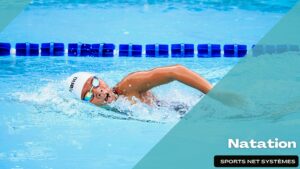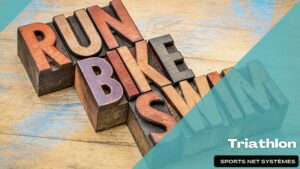Coordinated backstroke unifies the individual actions of the stroke into a seamless effort forward. With each part working together, the backstroke becomes easier, smoother, and more comfortable, as well as more productive. The goal of the following coordination drills is to bring together the many elements that contribute to a good backstroke and to use them in combination for efficient backstroke action.
Roll, Pull, Roll, Push
THE PURPOSE OF THIS DRILL
- Blending the actions of the roll and the arm stroke
- Initiating the arm stroke from the core
- Coordinating backstroke action

HOW TO DO THIS DRILL
- Step 1 : – Push off the wall on your back, both arms extended, preparing to do the backstroke, straight spine, good water-line, productive kick. Swim to the other end of the pool focusing on identifying the pull phase and the push phase in your backstroke arm stroke.
- Step 2 : – Swim another length of backstroke, this time focusing on identifying the roll or switch from one side of your body to the other.
- Step 3 : – Now, swim a length of backstroke timing the pull phase of the underwater arm stroke to begin as you switch toward the underwater arm. Then, with the same arm, time the push phase of the stroke to begin as you switch away from the underwater arm.
- Step 4 : – Swim several lengths of the pool, focusing on the timing of roll, pull, roll push. Concentrate on one arm at a time. Once coordinated with the first arm, concentrate on the other arm to see if your timing also follows roll, pull, roll push.
- Step 5 : – Practice until you can increase your stroke rate and still maintain this timing. This is the ideal backstroke coordination.
DRILL FEEDBACK CHART
| Problem | Modification |
| This timing helps my pull but not my push. | Be sure you are switching with your hips as well as your shoulders in a unified action. Without your hips rolling too, your push will not benefit. |
| This timing helps my push, but not my pull. | Be sure your recovering arm is aligned with your shoulder so it has the range of motion to descend twelve inches into the water at entry with the roll. Without this depth, the pull will not be of benefit. |
| I lose the timing when I increase my stroke rate. | Think of it as a transition, instead of a pause. Both the recovering arm and underwater arm are moving at the point of the armpit lift. There should be no pause, just a feeling the arms are balancing each other and unified in their action. |
Med Hassan EL HAOUAT
![]()
Pinkie Lead
THE PURPOSE OF THIS DRILL
- Using the hip roll to initiate the recovery
- Eliminating extraneous actions
- Learning to avoid shoulder pain
HOW TO DO THIS DRILL
- Step 1 : – Push off the wall on your back, both arms extended, preparing to do the backstroke, straight spine, good water-line, productive kick. Swim backstroke to the other end of the pool focusing on your hand at the end of the push phase of the arm stroke, just before recovery. Notice that your thumb is closest to your body as it finishes the push, and the pinkie is to the outside. In this position it is the back of the hand that exits first for recovery, creating a large hole in the water, and lifting heavy water upward into the recovery.
- Step 2 : – To avoid this, traditionally, most swimmers have been taught to flip their hand to a thumb up position to exit the water, then flip their hand again during recovery to achieve a pinkie first entry at the end of recovery. Although the thumb-lead position avoids more drag than exiting with the back of your hand, it requires the additional action of flipping your hand over and then back again. This action is done independently from the roll, making the arm work harder. In addition, if not done early enough in the recovery, the second hand flip can contribute to shoulder pain. Practice the thumb-first recovery, initiating the flip to pinkie leading before your hand reaches the top of the recovery arch.
- Step 3 : – The alternative to flipping your hand, before and again during recovery, is to allow your roll to position your hand for recovery. Swim Backstroke to the other end of the pool, feeling core stability that unites your shoulders and hips. Focus on your shoulder of the arm that is finishing the push phase of the underwater stroke. As the hand finishes the push, deliberately pop the same side shoulder out of the water just as your hand passes your hip. Notice that as you do this deliberate movement with your shoulder, your same hip will also rise. Practice to the far end of the pool.
- Step 4 : – Now, swim another length of backstroke, focusing on popping your shoulder out of the water, and allowing your same side hip to rise at the point when your same side your hand is finishing the push. Freeze in that position. Observe that having rolled, it is the pinkie that is positioned to exit the water first for recovery. With the pinkie leading the recovery from start to finish, there is no need to flip the hand over and back, or to make sure the second flip is done early in the recovery to avoid shoulder pain.
- Step 5 : – Repeat this drill, maintaining unified hip and shoulder action. With each stroke, deliberately pop your shoulder out of the water as your hand finishes the push. Feel your hip rise as your hand is finishing its push. Then, as the hip continues its switch, let it lift your hand out of the water in the same position the hand finished the push, pinkie leading. It is just less work than a thumb-lead recovery.

DRILL FEEDBACK CHART
| Problem | Modification |
| To accomplish a pinkie leading recovery, I have to roll more. | Exactly. Maximize the benefit of your roll. Let it do the work of lifting your hand out of the water. Rest all you can during recovery. |
| With the pinkie leading, the recovery seems to be opposite to the way I was taught. | Yes, most of the teaching theory for swimming is based on using a flatter stroke, which depends more on arm and leg power alone. Incorporating leverage from the core changes the dynamics of swimming in many ways, including the under-recognized opportunity to let your roll action position your hand for recovery, pinkie leading. |
| So, a thumb-first recovery is fine as long as I flip my hand over early in recovery. | It is a widely accepted practice to exit thumbs-first. However, flipping your hand early in the recovery is worth trying, if only as a preventive measure to avoid shoulder pain that affects many backstrokers. |
Med Hassan EL HAOUAT
![]()
Backstroke Balance Drill with Cup
THE PURPOSE OF THIS DRILL
- Developing a balanced, effective backstroke
- Developing continuous backstroke motion
- Maintaining a stable head position while swimming backstroke
HOW TO DO THIS DRILL
- Step 1 : – Fill a medium plastic cup half-way with water. Gently balance the cup on your forehead as you lay horizontally in the water, face up, straight spine and good water-line. Once the cup is balanced, position both arms extended over your head. Kick productively.
- Step 2 : – Begin the underwater stroke with one arm, rolling smoothly into the stroke, while your head stays still, centered and neutral. Keep Balancing Cup on Forehead the cup of water balanced on your forehead. When the first arm passes your hip, begin stroking with the other arm. If the cup falls off, stand and start again.
- Step 3 : – Practice until you can swim smoothly for several strokes without the cup falling off your forehead.
- Step 4 : – Swim backstroke again, with the cup on your forehead, increasing your stroke and kick rate, and maintaining your stable, neutral head position. Roll smoothly from side to side, and with your hips and shoulders united, While they are opposite, feel the movement of both of your arms initiated at once by a single action of the core. This is ultimate backstroke.

DRILL FEEDBACK CHART
| Problem | Modification |
| The cup falls off right away. | Work on relaxing your neck muscles, so your head does not move with your shoulders. It should feel like your head is separate, floating ahead of your body. |
| The cup falls off when my hand enters the water. | Be sure you are not doing a wide kick at this point to help your arm enter the water with speed. You also might be entering the water with the back of your hand, which makes a big splash, rather than slicing the water smoothly by entering pinkie-first. |
| The cup falls off when I am recovering | If your recovery is aligned over your face, it will drop water onto the cup on your forehead, knocking it off. Practice aligning your recovery over your shoulder, and aiming for a 1:00 entry. |
Med Hassan EL HAOUAT
![]()
Opposition Overlap
THE PURPOSE OF THIS DRILL
- Recognizing the momentary non-opposition point in the backstroke
- Making the most of both arms pressing on the water at once
- Feeling a continuous stroke
HOW TO DO THIS DRILL
- Step 1 : – Push off the wall for backstroke, achieving a straight spine, good water-line, and productive kick. Swim backstroke to the other end of the pool. Focus on the opposition of the arm stroke. When one arm is under the water, one arm is over the water. When one arm is in mid-stroke under the water, the other arm is in mid- recovery.
- Step 2 : – Now focus on the point when one arm is starting the stroke, and the other arm is finishing the stroke. This sounds opposite. As you swim, feel what is really happening. As one arm is entering the water and descending about twelve inches downward, the other arm is still pushing past the hip. Both arms are in the water at the same time. Both are in the power phase of the stroke at the same time. For a moment, the arms are actually not opposite.
- Step 3 : – Continue swimming backstroke, feeling this moment of overlap. Feel how the roll of the stroke assists both arms, one to start the arm stroke, the other to finish the arm stroke. Use this moment to start your stroke with power, and to finish your stroke with power. Practice more until you can feel both arms engaged in the power phase of the stroke at the same time, at opposite ends of the stroke.
- Step 4 : – Kick to assist both the beginning and the end of the stroke. Feel the balance of the stroke shift from the finishing arm to the starting arm. Opposition is reset as the beginning arm sweeps into its anchored position at the same time as the other arm clears the water. Practice for several lengths of the pool. Develop a continuous stroke, using the moment of stroke overlap to access more power than with one arm at a time.

DRILL FEEDBACK CHART
| Problem | Modification |
| I don’t feel the overlap. | Make sure your entry hand is descending down into the water, and not stroking from the surface of the water. Also, make sure you are finishing the stroke by pushing all the way past your hip. The overlap happens when these two actions occur simultaneously. |
| I am flat at this point. | Make sure your arms are in continuous motion, and not stopped, one extended and one at your side. You should be in transition, rolling toward the side with the arm entering, and away from the side with the arm finishing. Practice this transition to make more use of leverage from your core. |
| My finishing arm is already at my side. | Stroke past the hip instead of into the hip. This will give you a longer stroke, establish the overlap, and create a continuous stroke. |
Med Hassan EL HAOUAT
![]()







